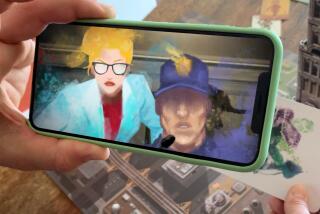THE GOODS : Beware, Computer-Game Addicts
- Share via
If your New Year’s resolution was to stop wasting time in front of the computer, do not read this column.
Two highly addictive, time-eating games have recently been released--one completely new and the other a repackaged favorite. Both are the kind of computer games that suck you in, leading to 3 a.m. promises that if you can solve “just one more level,” you’ll get on with your life. For a little while.
The first is “Karma: Curse of the 12 Caves,” a new CD-ROM from the Toronto-based Discis ompany, which previously released the elegant puzzle game “Jewels of the Oracle.” “Karma” is, if anything, even more elegant. It’s set in the famed caves of Dunhuang, a northern China oasis along the Silk Route. The town was a major Buddhist monastic and pilgrimage site where, beginning in the fourth century, a series of ornate sanctuaries was cut into the rock walls of nearby caves. They came to be known as Qianfodong, the Caves of the Thousand Buddhas.
The game is based on a legend about a sacred well hidden deep among the caves where a demon is trapped. You are called upon to solve a series of puzzles that will eventually lead you to the well and a puzzle battle with the demon. If you win, the sacred, healing waters of the well are released to a grateful world.
But unless you are a genius at puzzles, or heavily avail yourself of hints printed at the Discis site on the World Wide Web, it will be a long time before you meet that demon. These are tough, adult-strength puzzles that take a good deal of contemplation and patience to unravel.
For example, the second puzzle you come upon, after clicking through the cave portals, depicts six Buddha statues sitting around a giant abacus. By carefully studying this scene, you can figure out which of the abacus beads should be moved. When you get it right, the scene disappears and you are moved to the next part of the game.
The graphics, based on ancient Buddhist artifacts and images, are spectacular, and “Karma” features a musical score far more sophisticated than the computer game norm. This is good, because if you get hooked on “Karma,” you’re going to be hanging around those caves for a long time. The “Karma” CD-ROM for both Macintosh and Windows sells for about $40.
“Prince of Persia” first appeared in the early 1990s and was one of the first hit computer games. The aim was simple. You had to move the handsome prince through a castle until you reached your true love, a princess being held captive by an evil vizier. Along the way you fought sword fights with numerous guards while avoiding sharp spikes and other pitfalls.
Not a very inspiring plot line, but “Prince of Persia” was special because the levels were wonderfully clever, requiring great resourcefulness on the part of the player. Secondly, the graphics and movement of its animated characters were stunningly beautiful.
The follow-up game, “Prince of Persia 2,” was also beautifully done, although I found the first a bit more elegant and satisfying. Both games, originally distributed on floppy disks, have now been packaged into one DOS and Macintosh CD-ROM distributed by Broderbund software at a list price of $19.95.
Playing “Prince” was like meeting up with an old friend. It has aged gracefully, and it is still more entertaining than the vast majority of newer games featuring videos and all kinds of other bells and whistles.
* Cyburbia’s e-mail address is David.Colker@latimes.com.
More to Read
The biggest entertainment stories
Get our big stories about Hollywood, film, television, music, arts, culture and more right in your inbox as soon as they publish.
You may occasionally receive promotional content from the Los Angeles Times.











